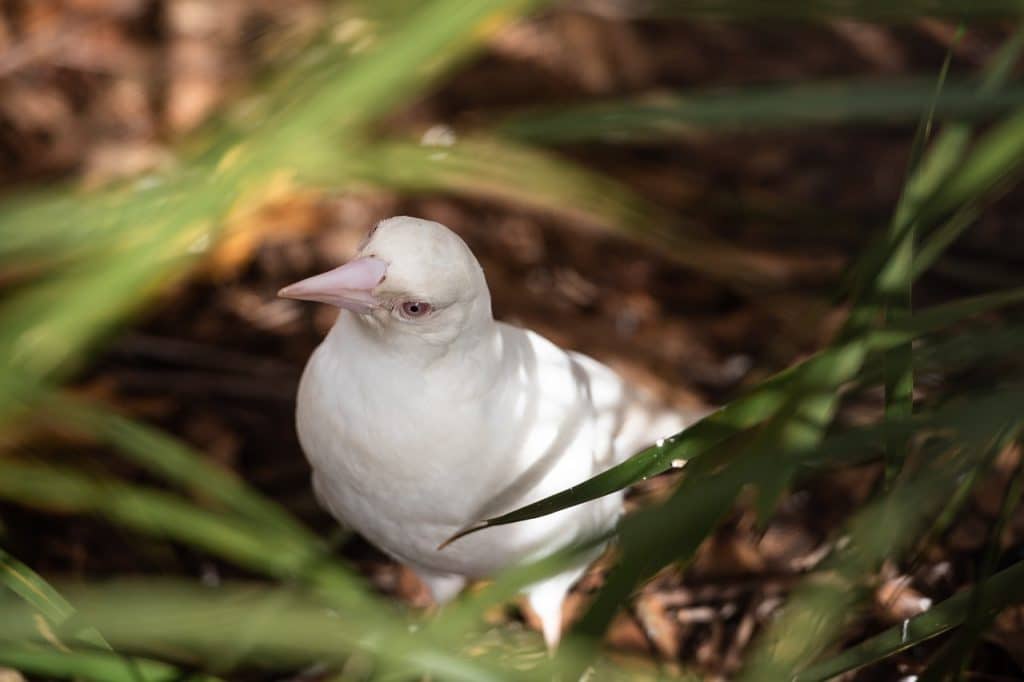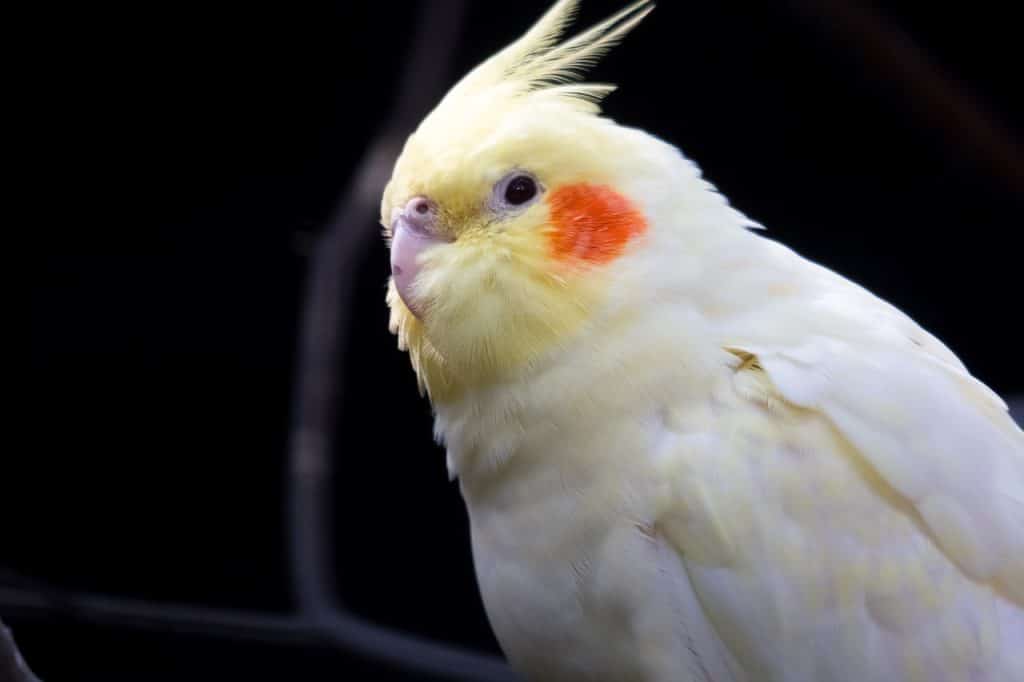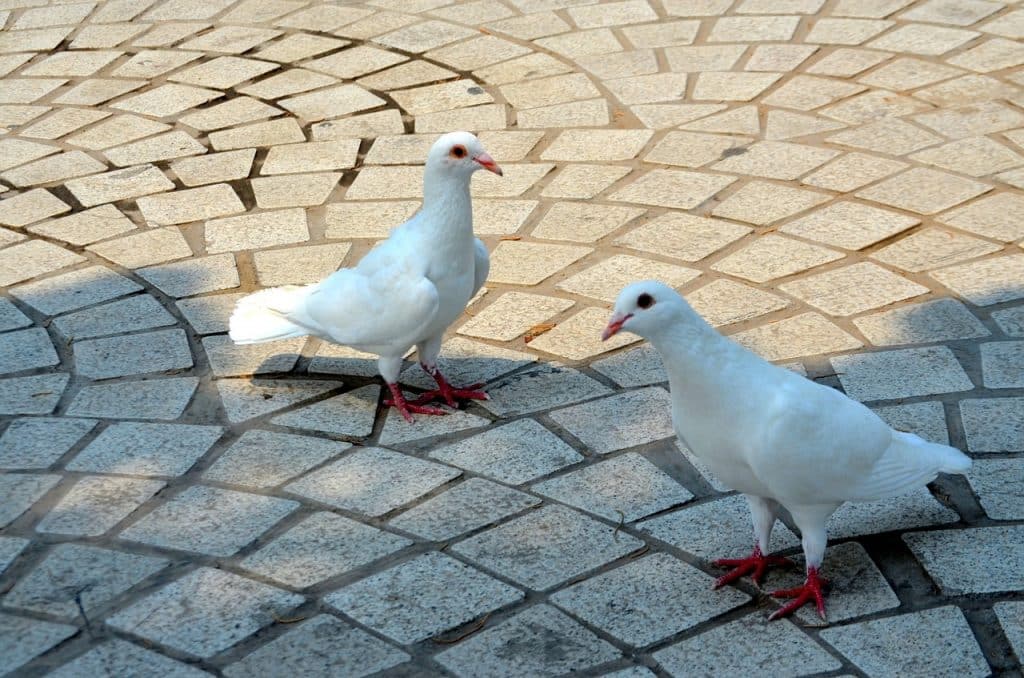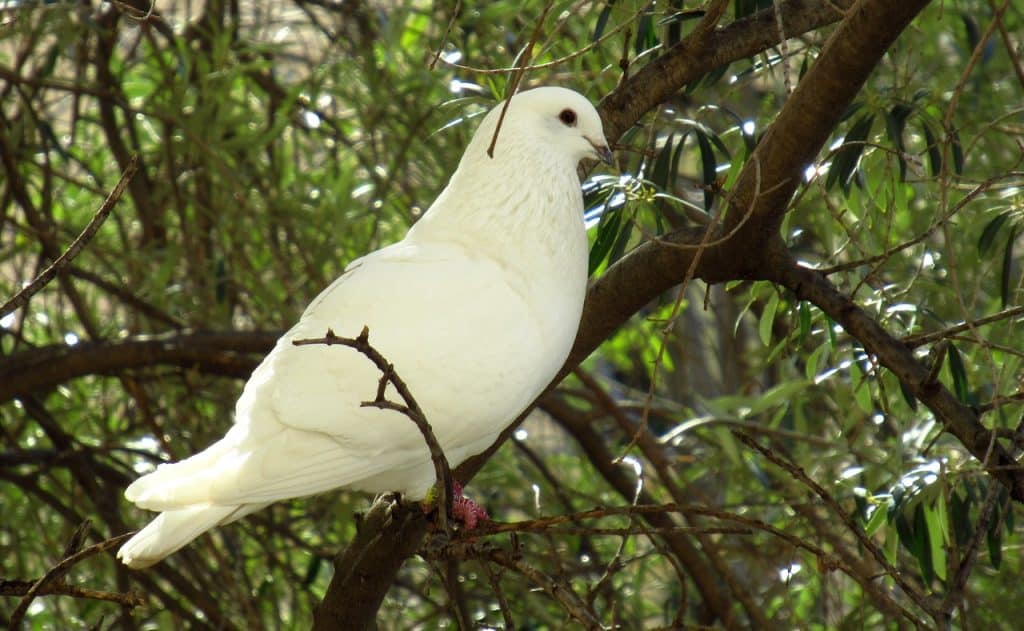
Albino Cockatiel may not be albino. It is sometimes called White-Faced Lutino Cockatiel. It’s a mix of a Lutino Cockatiel, and a White Faced Cockatiel. The Lutino is a combination of a White-Faced Cockatiel and a Lutino. It has orange cheeks, red eyes, and white to pale yellow feathers. The White-Faced Cockatiel, on the other hand, is grey with smoky or light gray faces. The Albino Cockatiel is a double mutation because both the White-Face and the Lutino are mutations.
Cockatiels belong to the Cockatoo Family, which is native to Australia. It is second in popularity among caged birds (the Budgerigar is number one).
Species Overview

| Common Name: | Cockatiel |
| Scientific Name: | Nymphicus Hollandicus |
| Adult Size: | 12-13 inches |
| Life Expectancy: | 15 Years |
Origin and History
The origin of the Albino Cockatiel is not known. Since the 1940s, the “normal grey” Cockatiel was bred to a range of color mutations. The Lutino was the first color mutation introduced in America. The White-Faced Cockatiel was first introduced in 1964. It is still a popular mutation.
The Albino Cockatiel’s unique appearance is due to the combination of the White-Faced Lutino and White-Faced. The Lutino gene takes out the grey and black of the White Faced and adds red eyes. While the White-Faced gene gets rid of all the Lutino’s orange and yellow colors, the White-Faced gene does the same. You end up with an all-white bird that has red eyes. This is not an albino, but it was given this name.
Temperament

Cockatiels love being social and enjoy spending time with their families. They are energetic and playful. They can also be taught a few tricks and hand gestures. They can talk, but not as much as other parrots. They may whistle or sing to you to show affection.
Cockatiels have been popular pets for many years because they are gentle and very intelligent. Cockatiels are generally quieter than their male counterparts, and they tend to be sweeter and calmer. They love to be held and petted. They are social and will be more comfortable with other Cockatiels if you’re not home. A well-socialized Cockatiel will be a gentle, friendly, and docile bird.
- Can be taught how to speak.
- Sweet, gentle, and docile
- They are smart and can be taught a few tricks.
- Social and loving.
- Albino Cockatiels have red eyes which is a sign they lack pigment. They are very sensitive to light, so they won’t be able to adapt well to bright lighting.
- If you’re not home often, you will need to feed more than one bird.
- Cockatiels tend to nip if they aren’t socialized well.
Vocalizations & Speech
Cockatiels can talk but at a very limited level. Cockatiels can mimic certain sounds outside and within the house, including other birds and phones or alarm clocks. Although they can chirp and whistle when they feel happy, they may also make a variety depending on the situation.
Cockatiels will shout if they feel threatened or startled. They also may scream when they feel bored or lonely. If they want to intimidate another bird or you, they may hiss and then bite. It is a warning signal.
Albino Cockatiel Colours and Markings

Albino Cockatiels are pure white birds with bright red eyes. However, the female Albino Cockatiel can have tail barring (a type or color pattern) on her tail. Clear Pied Cockatiels are white birds with dark eyes.
Below is a list of all the color variations and mutations available to the Cockatiel.
- Albino: Red eyes and white feathers.
- Normal Grey: This is the original Cockatiel. It has a grey body with white wings and a yellow face.
- Lutino: A pale yellow or white bird, with an orange mask, yellow cheeks, and red eyes.
- Pied: A mixture of yellow or white with dark or light gray.
- Pearl, laced or opaline: A tiny pearl-like appearance that is created on feathers by spotting various colors.
- Cinnamon, fawn, or Isabelle: Gray feathers of warm cinnamon to brown color.
- Silver: While dominants have brighter silvery-gray tones and darker eyes, dominants have lighter silvery-grey feathers.
Caring for the Albino Cockatiel
Bade-taking
Cockatiels require frequent baths because they produce excessive powder, or “feather dust,” so you should offer a bowl of cool or room temperature water to them two to three times per week. You can also spray a spray bottle to mist their Cockatiel.
Trimming Wings
Although this is controversial, some households may find it necessary. It may be safer to clip the wings of your Cockatiel if you have children or lots to do in your home.
This practice could put your bird at risk as it will not be able to fly to safety in hazardous situations, such as being stepped on or with other pets. They also get a lot of exercise flying is a great way to keep fit. You can decide if your Cockatiel is most comfortable having its wing trimmed. If so, you should take it to your vet. Otherwise, you risk injuring your bird.
Trimming nails and beak
The beak and nails both grow constantly, so you might need to trim them both. To have your Cockatiel’s beak professionally trimmed, take it to the vet.
The Cockatiel, as we have already said, is a social bird and will require another bird of the same species to keep it company when you are away from home. A single Cockatiel is fine if you live at home most of the time. Your Cockatiel should spend time with you every day to avoid self-destructive behavior.
Common Health Problems
Cockatiels are susceptible to the following health issues:
You should immediately take your Cockatiel to the vet if you see any of these symptoms.
- Feathers that are messy and unorganized
- Watery, stale droppings
- Head and drooping wings
- Signs of difficulty breathing include wheezing, sneezing, or wheezing
- Resting at the bottom of the cage
- Do not discharge around the nasal cavities
Nutrition and Diet
Cockatiels can be fed seeds, fruits, vegetables, legumes, and other foods. Cockatiels prefer seeds, but excessive intake of high-fat seeds can cause obesity and other health problems.
Although pellets are ideal for Cockatiels, it can take several months to transition from seeds to pellets if the bird is an older one. Pellets should account for 75 to 80% of your bird’s diet. Fruit and vegetables make up the remaining 20-25%.
Avocados are toxic and should be avoided.
Exercise
Your Cockatiel should be allowed to fly for at least 1 hour each day. This will help with exercise and socialization. You should ensure that your Cockatiel can fly freely in the cage it is in.
As toys and perches for your Cockatiel, make sure they don’t take up too much space in the cage.
Albino Cockatiel Adoption and Purchase
Albino Cockatiels are rarer than other color mutations. This makes it more difficult to find and more costly. If you are looking for Albino Cockatiels, there may be breeders in your area. They can help you find one. Check your local pet shop (smaller, independent stores are often better than larger national chains) and bird rescues. An Albino will cost you between $300 and $400 if it is purchased from a breeder.
Conclusion
Albino Cockatiels are a unique birds with beautiful eyes that make them great pets. Before you bring one home, do your research on the Cockatiel and all that it can offer before making a decision. This breed is a great choice for anyone who wants a playful and affectionate pet. They will require a lot of care but will also provide companionship and entertainment.
Is there a cockatiel that is albino?
Albino cockatiels are created by mating two other cockatiel morphs: whiteface cockatiels and lutino cockatiels. Lutino cockatiels have white or yellowish plumage with bright orange markings on their cheeks.
Are white cockatiels uncommon?
These birds were once much rarer than they are now. You can now find breeders who specialize in white-faced cockatiels. However, you are unlikely to find them elsewhere.
Do cockatiels become envious?
Birds can become jealous and territorial, but with the right steps, you can reduce tension and counteract your bird’s jealousy. Small birds are frequently envious of other birds in the house, family members, or even one of their toys!
Cockatiels do recognize their owners?
Yes, cockatiels can recognize and differentiate their owners from other people. Despite their small size, they are incredibly perceptive, intelligent, and intelligent birds. Cockatiels are gregarious birds.
Which cockatiel has the longest lifespan?
Grey cockatiels are the natural color and genetically the strongest cockatiels. At the age of 26, your bird has outlived the average cockatiel. Because of mutation and, sadly, inbreeding, many cockatiels live only 12 years.
Are albino birds uncommon?
Albinism is uncommon in birds, with estimates ranging from 0.05% to 0.1%.
What is the world’s most endangered bird? Overview: Only one Stresemann’s Bristlefront is known to survive in the wild, making it the world’s rarest bird. Unfortunately, this bird is restricted to one of the Americas’ most fragmented and degraded – and thus vulnerable – forests.
Do albinos live a long time?
The majority of people with albinism live normal lives. People with Hermansky-Pudlak syndrome and Chediak-Higashi syndrome are more likely to die young due to associated conditions.
Are albino birds deaf?
The pigment is also important in the eye, allowing it to function properly and protecting it from UV rays. As a result, true albino birds have poor vision and rarely reach adulthood
What do you call white cockatiels?
Cockatiels with light colors are frequently referred to as white or even albino. This is due to the fact that their coloring frequently appears white. However, the terms albino and white are misleading. The so-called “white” Cockatiel is actually a lutino Cockatiel with a white face. Lutino frequently describes pastel yellow hues.